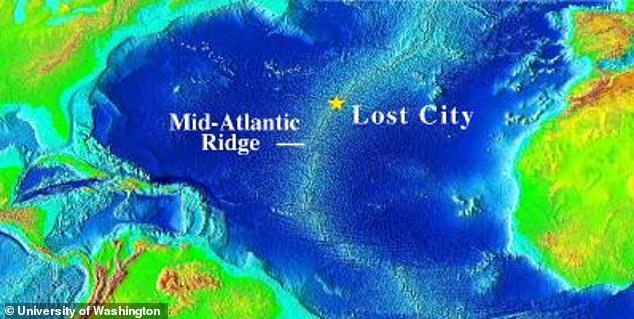Scientists make breakthrough after digging 4,000 feet beneath ‘Lost City’ in Atlantic Ocean
Scientists may be on the verge of a scientific breakthrough into how life forms after drilling deeper into Earth than ever before.
The record-breaking study a long piece of rock exposed from the Earth’s mantle – the layer of solid rock between the planet’s inner core and outer crust.
They drilled a rock core more than 1,200 meters long from a spot in the Atlantic Ocean called the Lost City Hydrothermal Field, or better known as the Lost City.
Their findings, published in the journal Science, provide a better understanding of the chemical reactions that enabled the emergence of life in the depths of the ocean.
Scientists have taken a huge sample of Earth’s mantle after drilling deeper into the planet than ever before.
The researchers say that with further analysis, the rocks could help answer questions about the origins of life on Earth and how the mantle drives volcanic activity and key global cycles.
Led by researchers from the Universities of Cardiff and Leeds, the scientists travelled to the Lost City, a site approximately 1,500 miles east of South Florida, and extracted a core from the Earth’s mantle at a nearby location.
The Lost City is located along the Mid-Atlantic Ridge, one of the largest undersea mountain ranges in the world, stretching 10,000 kilometers.
Despite what its name suggests, the Lost City is not the site of a sunken Atlantis. It is actually a ‘bizarre’ hydrothermal vent system where seawater circulates beneath the seabed.

The researchers drilled their core near the “Lost City,” a system of hydrothermal vents along the Mid-Atlantic Ridge.
It caught the attention of scientists because it produces vents as tall as 18 stories – the tallest ever seen – and the fluids that make up these vents are heated by the reaction of seawater with millions of years old rocks in the Earth’s mantle.
That may not sound as exciting as a mysterious civilization that disappeared into the ocean, but experts say these openings are hugely important because they could hold secrets about how life emerged on our planet billions of years ago.
“The reaction between seawater and mantle rocks on or near the seabed releases hydrogen, which in turn forms compounds such as methane, which are the basis for microbial life,” said lead researcher Johan Lissenberg, a geologist at Cardiff University.
“This is one of the hypotheses for the origin of life on Earth.”

Lead researcher Johan Lissenberg of Cardiff University and two colleagues analyse the mantle rock sample. Their initial findings are already surprising.
The researchers drilled into mantle rock at a depth of 850 metres below the sea surface using equipment on board the research vessel JOIDES Resolution.
They found large swaths of continuous mantle rock, which should be representative of the mantle rock beneath the Lost City vents, the researchers said.
“The recovery is record-breaking, as previous attempts to drill into mantle rocks were difficult. Penetration was no deeper than 200 meters (656 feet) and the recovery of rock was relatively low,” Lissenberg said.
He and his colleagues documented how a mineral called olivine in the core sample reacted with seawater at different temperatures.
By studying these and other reactions between seawater and mantle rock minerals, scientists can gain more insight into how microbial life first arose in the depths of the ocean, Lissenberg explains.
The researchers also made some surprising initial discoveries about the composition of the core sample, such as the discovery that the melting period (molten rock) lasted longer than expected.
